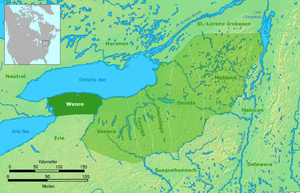Wenrohronon

The Wenrohronon or Wenro were a little-known Iroquoian language-speaking indigenous people of North America, originally residing in present-day western New York and northwestern Pennsylvania. They appear to have inhabited the upper Allegheny River valley, between the territories of the Seneca and the Neutrals.
The Wenro were recorded by Franciscan missionary Joseph de La Roche Daillon in 1627, who encountered them at the site of Oil Springs. Daillon noted the tribe's use of crude petroleum (then a largely unknown substance) as an alleged medicine. A falling-out with their former allies, the Neutrals, made it impossible for the Wenros to withstand their long-time enemies, the Iroquois.[1] Along with the Neutral and Erie nations, the Wenro were ultimately conquered by the Iroquois nations during the Beaver Wars of the 17th century.[2]
Survivors were assimilated into the victorious nations. Many were absorbed into the Seneca Nation, whose descendants inhabit the territory today. Remaining survivors were exiled into Huron territory.[2]
Language
| Wenro | |
|---|---|
| Region | New York, Pennsylvania |
| Extinct | 17th century |
|
Iroquoian
| |
| Language codes | |
| ISO 639-3 |
None (mis) |
Linguist list |
qgv |
| Glottolog |
wenr1236[3] |
Wenrohronon was an Iroquoian language and thus was related to Susquehannock, Wyandot, Erie and Scahentoarrhonon.[4]
See also
References
- ↑ http://puffin.creighton.edu/jesuit/relations/relations_17.html
- ↑ 2.0 2.1 "Vol 5". Handbook of North American Indians. 2012-12-12.
- ↑ Nordhoff, Sebastian; Hammarström, Harald; Forkel, Robert; Haspelmath, Martin, eds. (2013). "Wenro". Glottolog. Leipzig: Max Planck Institute for Evolutionary Anthropology.
- ↑ "Wenrohronon". Accessgenealogy.com. 2012-12-12.